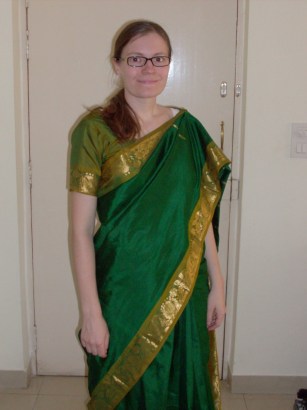Before I came to India, I pictured saris as special occasion-wear – fancy, nice, and expensive. Now I know better. “Work saris” are sold for as little as 99 rupees (just over $2). Weddings, church attendance, and holidays bring out fancy wear for all women, but the every day use of saris varies.
To broadly generalize, saris are worn in very cheap materials by very poor women…
and in silk by wealthy, older women. This is my brother’s mother-in-law in a silk sari. She has it tucked into her petticoat as a work sari, but she wears silk every day.
Nearly everyone in between (for example, women working in call centers) wears a salwar kameez – a tunic, pants, and scarf set, modeled below by my house helper (she hates to wear saris. I interrupted the dishes to take her picture, so excuse the water).
A sari is a single piece of fabric (around 6 meters), wrapped and tucked (or pinned) over a short blouse. They come in all kinds of fabrics and patterns and range from super-cheap to very expensive. Cheap sari…
Expensive sari. This sari was a gift from my brother’s mother-in-law and cost more than my wedding dress.
Saris can be very useful items of clothing. You can use the end to blow your nose, clean your child’s face, or cover your hair and face during a dusty rickshaw or motorcycle ride.
Oh, and they can double as swimming suits.
While we’re discussing women’s fashion in India, I’ll also mention that there are quite a few Muslim women here. Many of them wear a black hijab, but again, the working women usually just wear a colored scarf over their hair with their Western wear.
Also, nose rings and toe rings are incredibly popular among Indian women. Here is Kannagi again with her nose ring and five ear piercings, including a chain that connects two of them. Most women also wear a bindi on their foreheads. This is required for married Hindu women, and though many Christians also follow this custom, Kannagi does not.
If you’re new to my Frugal Foreigner posts, read all about what we’re doing in India here! You can read all previous posts in the series here.










Thanks for posting this interesting information about Indian dress. I learned a lot!
Thanks for posting, Susie! You look lovely in your sari. Was that one expensive? It’s hard to imagine blowing your child’s nose with something so pretty.
Thanks so much for sharing Susie~ I am learning so much from your stay in India:)
Susie, this was so interesting. I am really enjoying hearing about your life in India.
Oh, you wouldn’t wipe your child’s nose on a silk sari, but a cotton one, sure. The silk is too stiff, anyway.
The sari I have was around $125.
My mother received a beautiful sari as a gift from a neighbor many years ago. Is there any particular way to put it on and wear it? She has had it in storage since she received it because we had she idea how to wear it.
Yes, I actually had a difficult time putting it on myself the first time, and after that I left it pinned to make it easier. You tuck it in your petticoat, wrap it around your waist, pleat it, tuck the pleats in, then wrap the rest up over your shoulder and pin it to your blouse. And it’s not as easy as it sounds!